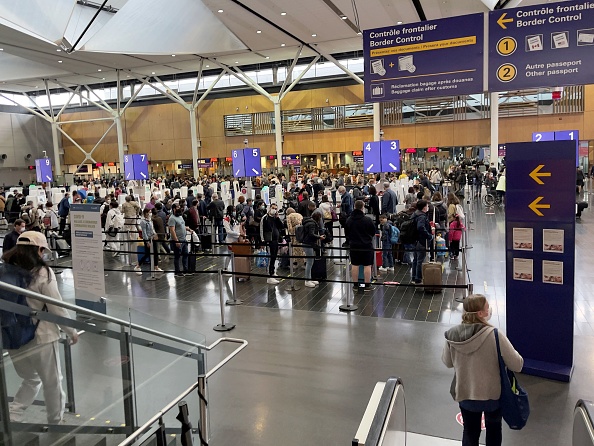
Passport control at Montreal-Pierre Elliott Trudeau International Airport (YUL) on October 3 2021. (Photo by DANIEL SLIM/AFP via Getty Images)
By
The federal government has hinted that ArriveCAN, originally intended to provide travel and public health information during the COVID-19 pandemic, may be kept beyond the pandemic.
Public Safety Minister Marco Mendicino recently signalled the Liberal government’s plan to use the app to “modernize our border” and allow travellers to complete their customs declaration forms in place of the traditional paper forms and digital kiosks installed in Canadian airports.
“ArriveCAN was originally created for COVID-19, but it has technological capacity beyond that,” Mendicino said during a press conference on June 28.
The app, launched in April 2020, was initially a short-term policy to ensure travellers entering Canada during the COVID-19 pandemic would comply with the government’s 14-day quarantine rules. In November that year, it was made mandatory for all travellers, which Ottawa said would help contain the spread of COVID-19 and reduce imported cases.
On June 30, the federal government announced that existing COVID-19 restrictions will be extended for travellers entering Canada until Sept. 30, including the use of the ArriveCAN app.
A recent update to the app added the “optional” function to allow passengers arriving at Toronto Pearson and Vancouver International airports to submit their customs and immigration declaration prior to landing, reported Global News, which first reported on the issue. This feature will be expanded to Montreal’s Trudeau International Airport later this summer and to other airports in the future.
The Canada Border Services Agency (CBSA) said this feature was part of the government’s border modernization strategy that was already underway before the onset of the COVID-19 pandemic, and it was added to ArriveCan because people are already familiar with this app.
“Due to Canadians’ familiarity with the ArriveCAN app and its widespread association with border processing, the CBSA opted to incorporate the advance declaration components being developed into that platform rather than the distinct application envisioned,” a CBSA spokesperson told Global News.
“Once travel and public health measures are no longer needed, ArriveCAN will continue to be available for those who choose digital interaction at the border.”
Opposition
During a June 15 press conference, a group of mayors and business representatives from communities near the Canada–U.S. land border said the federal app discourages cross-border travel.
“Here in Niagara, 40,000 people count on tourism to feed their families. We’ve always said ‘follow the science.’ Well, the scientists are telling us now there’s no reason to have the ArriveCan app,” Niagara Falls Mayor Jim Diodati said.
Mark Weber, president of the Customs and Immigration Union, which represents CBSA employees, also said the app has contributed to delays at the border.
“The last few months have shown that ArriveCan neither facilitates cross-border travel nor does it improve operational efficiency. In fact, it does exactly the opposite,” he said during a House of Commons committee hearing on June 15.
When asked about the reasons behind the prolonged existence of the app, Deputy Prime Minister Chrystia Freeland said as the epidemiological situation changes in Canada, her government constantly looks at “which measures are appropriate and which are not, and constantly make modifications and adapt.”
ArriveCan, Freeland said, is one of the measures that were part of her government’s “highly-effective COVID response.”
“I do want to say one thing that Canadians should be quietly proud of—collectively, all of us together—and that is how we have gotten through COVID so far,” she said during a press conference on July 6.
“I think overall, yes, the measures that we all endured during COVID were unpleasant and were difficult, and … maybe you want to call it the ‘COVID recession hangover’ that we’re getting through right now is not pleasant. But let’s not lose sight of the fact that, by and large, these measures worked.”
Isaac Teo and Noé Chartier contributed to this article.